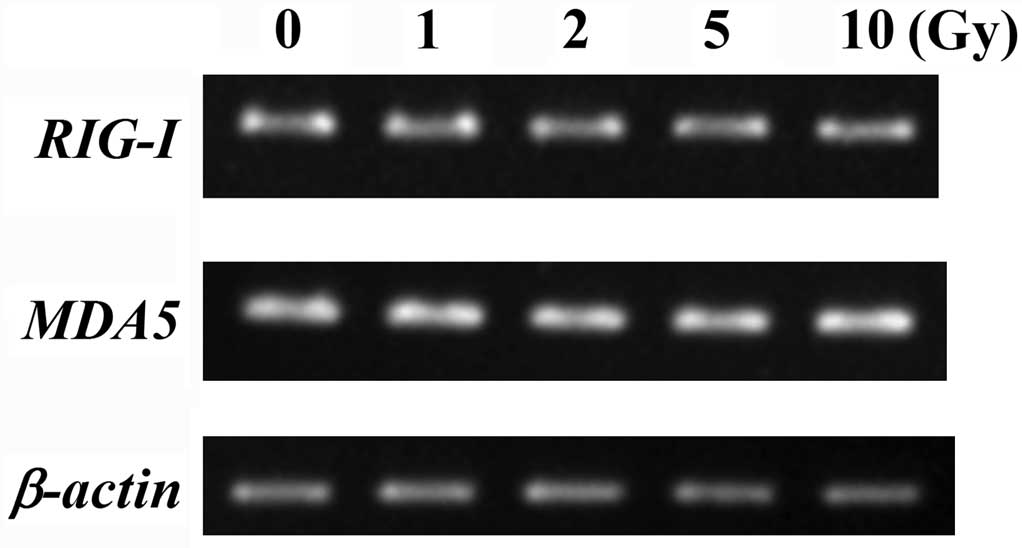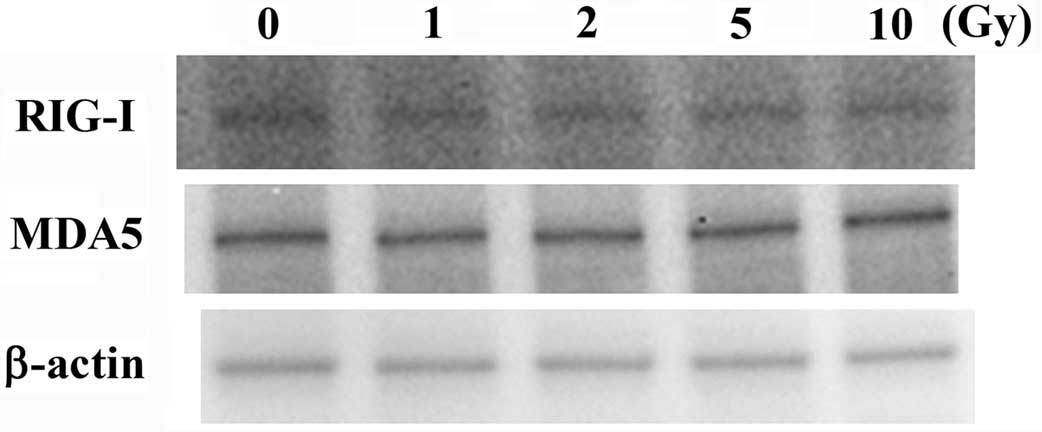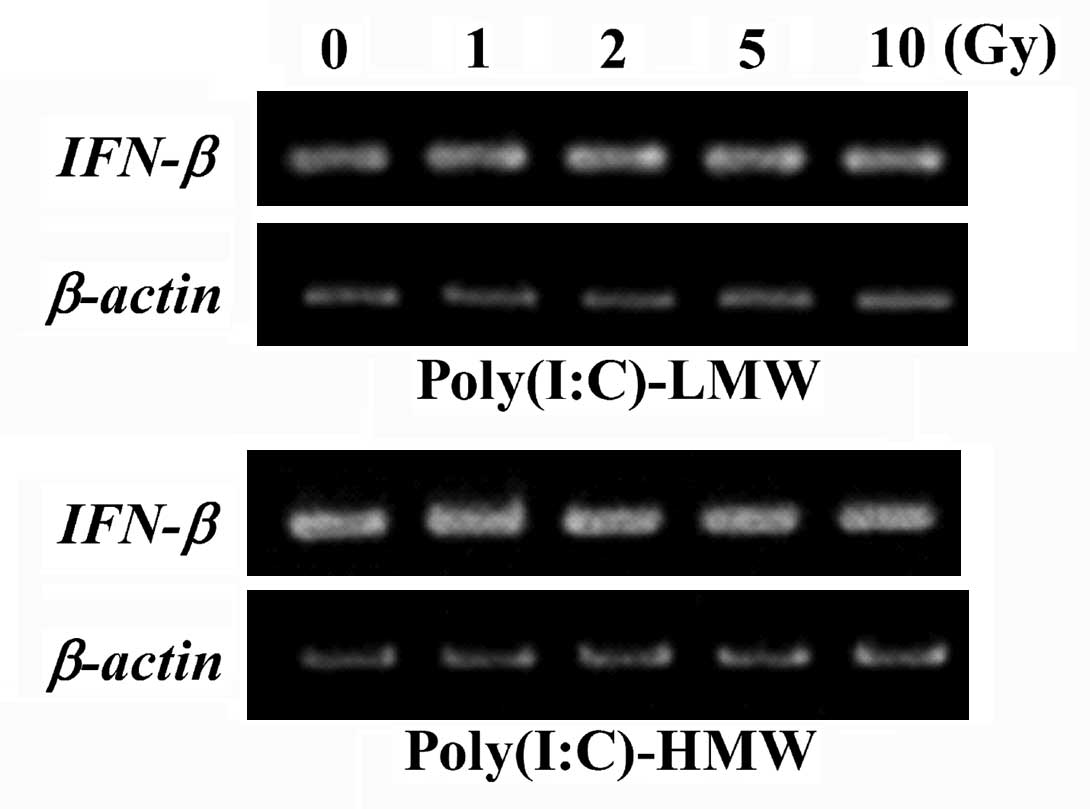Effects of ionizing radiation on retinoic acid-inducible gene-I-like receptors
- Authors:
- Published online on: November 7, 2014 https://doi.org/10.3892/br.2014.377
- Pages: 59-62
Abstract
Introduction
The innate immune system recognizes pathogen-associated molecular patterns through pattern-recognition receptors (PRRs). Thus far, numerous PRRs have been identified, including Toll-like receptors (TLRs), retinoic acid-inducible gene-I (RIG-I)-like receptors (RLRs) and nucleotide-binding oligomerization domain-like receptors (1–4). Among these receptors, RLRs are cytosolic virus sensors and are indispensable for antiviral immunity.
RLRs are DExD/H box-containing RNA helicases and play a key role in sensing RNA virus invasion (5). They consist of RIG-I, melanoma differentiation-associated gene 5 (MDA5) and laboratory of genetics and physiology 2 (LGP2). RIG-I and MDA5 contain N-terminal domains, consisting of the tandem caspase activation and recruitment domains (CARDs), the central DExD/H box RNA helicase domain and the C-terminal regulatory domain, whereas LGP2 lacks CARDs. RIG-I and MDA5 share structural and functional similarities, but they recognize distinct types of RNA viruses (6). RIG-I recognizes relatively short double-stranded RNA (dsRNA) and 5′ triphosphate-single-stranded RNA and are important in sensing influenza virus and hepatitis C virus. By contrast, MDA5 recognizes long dsRNA (7) and they sense picornaviruses. Subsequent to RIG-I and MDA5 sensing RNA virus invasion, they interact with a CARD-containing adaptor protein and interferon (IFN)-β promoter stimulator-1 through their CARDs, which results in the induction of antiviral cytokine type I IFN, such as IFN-β.
Our recent study investigated the effects of ionizing radiation on TLR2 and TLR4 using the human monocytic cell line THP1 and THP1-derived macrophage-like cells and showed that ionizing radiation affects these expression levels and the response to their agonist depending on the cell differentiation state (8). In THP1-derived macrophages, the expression of TLR4 was decreased following X-irradiation and the expression of its agonist lipopolysaccharide (LPS)-inducible IFN-β was attenuated by X-irradiation. These results indicate that the antiviral immune system of TLR4 in X-irradiated macrophages cannot properly respond to viral infections subsequent to LPS-containing gram-negative bacteria infections. Therefore, the antiviral immune system by RLRs is important in this situation. However, the effects of ionizing radiation on RLRs remain unknown. Therefore, the present study investigated the effects of ionizing radiation on the expression of RIG-I and MDA5 in THP1-derived macrophages and the response to their agonist, a dsRNA analogue polyinosinic-polycytidylic acid [poly(I:C)]/LyoVec™.
Materials and methods
Reagents
Phorbol 12-myristate 13-acetate (PMA) was purchased from Sigma-Aldrich (St. Louis, MO, USA). The poly(I:C)-low molecular weight (LMW)/LyoVec™ and poly(I:C)-high molecular weight (HMW)/LyoVec™ were purchased from InvivoGen (San Diego, CA, USA). Rabbit anti-human RIG-I (cat no. 4520), MDA5 (cat no. 5321) monoclonal antibodies and anti-rabbit immunoglobulin G (IgG) horseradish peroxidase (HRP)-linked (cat no. 7074) antibody were purchased from Cell Signaling Technology Japan, K.K. (Tokyo, Japan). Goat anti-human actin polyclonal antibody (sc-1615) and HRP-conjugated donkey anti-goat IgG (sc-2056) were purchased from Santa Cruz Biotechnology, Inc., (Santa Cruz, CA, USA).
Cell culture
THP1 human acute monocytic leukemia cells were obtained from RIKEN BioResource Center (Tsukuba, Japan). Cells were cultured in RPMI-1640 supplemented with 1% penicillin and streptomycin (Gibco, Grand Island, NY, USA) and 10% heat-inactivated fetal bovine serum (Japan Bioserum Co., Ltd., Fukuyama, Japan) at 37°C in a humidified atmosphere containing 5% CO2. THP1-derived macrophages (macrophage-like cells) were prepared as previously described (8). THP1 cells (2.0×105 cells/ml) were plated in 60-mm dishes (Iwaki, Tokyo, Japan) with 4 ml of medium containing 100 ng/ml PMA and cultured for 48 h. After the 48-h culture, the medium containing PMA was replaced with fresh medium not containing PMA and macrophage-like cells were used in experiments.
In vitro X-irradiation
X-irradiation (150 kVp, 20 mA, 0.5 mm Al and 0.3 mm Cu filters) was performed using an X-ray generator (MBR-1520R-3; Hitachi Medical Corporation, Tokyo, Japan) at a distance of 45 cm from the focus and a dose rate of 1.00 Gy/min.
Stimulation with poly(I:C)/LyoVec™
To stimulate RLRs, two types of poly(I:C)/LyoVec™ (InvivoGen), which is a complex of poly(I:C) and the transfection reagent LyoVec™, were used. In brief, macrophage-like cells were exposed to X-rays and 500 ng/ml poly(I:C)-LMW/LyoVec™ or poly(I:C)-HMW/LyoVec™ was added to the culture 24 h after X-irradiation. After an additional 24 h, cells were harvested for reverse transcription-polymerase chain reaction (RT-PCR) and western blot analysis.
RT-PCR
Total RNA was extracted using the RNeasy Mini kit (Qiagen, Valencia, CA, USA) and quantified using a NanoDrop (Thermo, Wilmington, DE, USA). cDNA templates were synthesized from 1 µg RNA using the iScript cDNA Synthesis kit (Bio-Rad Laboratories, Inc., Hercules, CA, USA), according to the manufacturer's instructions. PCR was performed using the AccuPrime™ Taq DNA Polymerase system (Invitrogen Life Technologies, Carlsbad, CA, USA). The primer sequences used are shown in Table I. The reaction conditions for RIG-I were 94°C for 1 min followed by 30 cycles of 94°C for 1 min, 55°C for 1 min and 72°C for 1 min, and subsequently 72°C for 10 min. The reaction conditions for MDA5 were 94°C for 1 min followed by 30 cycles of 94°C for 1 min, 64°C for 1 min and 72°C for 1 min, and subsequently 72°C for 10 min. The reaction conditions for IFN-β and β-actin were as reported elsewhere (8). The PCR products were confirmed using electrophoresis on ethidium bromide-stained 1.5% agarose gels.
SDS-PAGE and western blotting
Cells were harvested and suspended in CelLytic™ M Cell Lysis reagent (Sigma-Aldrich) containing 1% Protease Inhibitor cocktail (Sigma-Aldrich) on ice for 30 min. After centrifugation at 20,600 x g for 20 min at 4°C, supernatants were collected. The protein concentration was determined using the Bio-Rad Protein Assay kit and a SmartSpec™ plus spectrophotometer (Bio-Rad Laboratories, Inc.). Each lysate was mixed with 2X sample buffer (Bio-Rad Laboratories, Inc.) containing 5% 2-mercaptoethanol. After boiling for 5 min, proteins were separated using 4–20% Mini-PROTEAN® TGX™ Precast gels (Bio-Rad Laboratories, Inc.) and transferred onto polyvinylidene difluoride membranes of Trans-Blot® Turbo™ Mini PVDF Transfer pack (Bio-Rad Laboratories, Inc.) using the Trans-Blot® Turbo™ Transfer system (Bio-Rad Laboratories, Inc.). The membranes were blocked in TBST buffer [10 mmol/l HCl (pH 7.5), 100 mmol/l NaCl and 0.1% Tween-20] containing 4% ECL Prime Blocking agent (GE Healthcare UK Ltd., Little Chalfont, England). The membranes were probed with each primary antibody in Can Get Signal® Immunoreaction Enhancer solution 1 (Toyobo, Co., Ltd, Osaka, Japan) overnight at 4°C. Following the reaction with the primary antibodies, the membranes were labeled with HRP-conjugated secondary antibodies in Can Get Signal® Immunoreaction Enhancer solution 2 (Toyobo, Co., Ltd) for 1 h. The antigens were visualized by the ECL Prime western blotting detection system (GE Healthcare UK Ltd.).
Results and Discussion
In the present study, the effects of ionizing radiation on RIG-I and MDA5 in THP1-derived macrophage-like cells were investigated.
As shown in Fig. 1, macrophage-like cells expressed RIG-I and MDA5 at the mRNA level. Furthermore, they also expressed these receptors at protein level (Fig. 2). In addition, X-irradiated macrophage-like cells expressed RIG-I and MDA5 at mRNA and protein levels and these expression levels were identical to those of non-irradiated cells (Figs. 1 and 2). These results indicate that ionizing radiation neither affects transcriptional nor post-transcriptional regulation of RIG-I and MDA5 expression. Our recent study reported that ionizing radiation decreased the expression of TLR2 and TLR4 on macrophage-like cells; thus, showing that the effect of ionizing radiation on PRRs depends on the types of PRRs, particularly affecting the expression of TLR2 and TLR4. Certain stimuli, such as IFN-γ and LPS, have been reported to upregulate the expression of RIG-I, as well as TLR2 and TLR4 (9–11). Therefore, it is likely that ionizing radiation does not affect the signaling pathway required for the induction of TLRs expression by IFN-γ or LPS.
As the recognition of dsRNA, such as poly(I:C) through RIG-I or MDA5 leads to the induction of the antiviral cytokine IFN-β, IFN-β mRNA expression of macrophage-like cells following poly(I:C)-LMW/LyoVec™ or poly(I:C)-HMW/LyoVec™ stimulation was investigated. According to the manufacture's data sheet, the average size of poly(I:C)-LMW and poly(I:C)-HMW is 0.2–1 and 1.5–8 kb, respectively. Poly(I:C)-LMW and poly(I:C)-HMW/LyoVec™ are believed to be recognized by RIG-I and MDA5, respectively, as RIG-I and MDA5 recognize short (<0.3 kb) and long (>4 kb) poly(I:C), respectively (7). Although non-stimulated macrophage-like cells did not express detectable IFN-β mRNA (data not shown), the expression of IFN-β mRNA was observed after treatment with poly(I:C)-LMW or poly(I:C)-HMW/LyoVec™ for 24 h (Fig. 3). The X-irradiated macrophage-like cells also expressed IFN-β mRNA following each poly(I:C)/LyoVec™ stimulation and their expression levels were identical to those of non-irradiated cells (Fig. 3); thus, indicating that X-irradiated macrophage-like cells retain the ability to induce IFN-β following poly(I:C) stimulation. Our recent study showed that the induction of IFN-β mRNA subsequent to LPS stimulation was lower in X-irradiated macrophage-like cells compared to non-irradiated cells (8), indicating that the antiviral immune system of TLR4 in X-irradiated macrophages cannot properly respond to viral infections following the gram-negative bacteria infections. However, this theory could be rejected by the present study as antiviral immune systems of RLRs normally function following exposure to ionizing radiation. By contrast, Besch et al (12) reported that RIG-I/MDA5 agonists induce proapoptotic signaling in human melanoma cells; thus, showing that the stimulation of RIG-I/MDA5 is a potentially useful therapeutic application in cancer treatment. Therefore, the present results also indicate a possibility that RLRs are an effective target for the induction of antitumor immunity during the radiation therapy. To confirm this possibility, further investigations regarding the antitumor effects of cotreatment with poly(I:C)/LyoVec™ and ionizing radiation are required.
Acknowledgements
The authors would like to thank Enago (www.enago.jp) for the English language review. The present study was supported by a JSPS KAKENHI Grant-in-Aid for Young Scientists (B; nos. 23791383 and 25861053). The study was also partially supported by a Hirosaki University Grant for Exploratory Research by Young Scientists and a Priority Research Grant for Young Scientists Designated by the President of Hirosaki University.
References
|
Creagh EM and O'Neill LA: TLRs, NLRs and RLRs: a trinity of pathogen sensors that co-operate in innate immunity. Trends Immunol. 27:352–357. 2006. View Article : Google Scholar : PubMed/NCBI | |
|
Yan H, Ohno N and Tsuji NM: The role of C-type lectin receptors in immune homeostasis. Int Immunopharmacol. 16:353–357. 2013. View Article : Google Scholar : PubMed/NCBI | |
|
Vabret N and Blander JM: Sensing microbial RNA in the cytosol. Front Immunol. 4:4682013. View Article : Google Scholar : PubMed/NCBI | |
|
Liu D, Rhebergen AM and Eisenbarth SC: Licensing adaptive immunity by NOD-like receptors. Front Immunol. 4:4862013.PubMed/NCBI | |
|
Matsumiya T and Stafforini DM: Function and regulation of retinoic acid-inducible gene-I. Crit Rev Immunol. 30:489–513. 2010. View Article : Google Scholar : PubMed/NCBI | |
|
Kato H, Takeuchi O, Mikamo-Satoh E, Hirai R, Kawai T, Matsushita K, Hiiragi A, Dermody TS, Fujita T and Akira S: Length-dependent recognition of double-stranded ribonucleic acids by retinoic acid-inducible gene-I and melanoma differentiation-associated gene 5. J Exp Med. 205:1601–1610. 2008. View Article : Google Scholar | |
|
Kato H, Takeuchi O, Sato S, et al: Differential roles of MDA5 and RIG-I helicases in the recognition of RNA viruses. Nature. 441:101–105. 2006. View Article : Google Scholar : PubMed/NCBI | |
|
Yoshino H, Chiba K, Saitoh T and Kashiwakura I: Ionizing radiation affects the expression of Toll-like receptors 2 and 4 in human monocytic cells through c-Jun N-terminal kinase activation. J Radiat Res. 55:876–884. 2014. View Article : Google Scholar : PubMed/NCBI | |
|
Faure E, Thomas L, Xu H, Medvedev A, Equils O and Arditi M: Bacterial lipopolysaccharide and IFN-gamma induce Toll-like receptor 2 and Toll-like receptor 4 expression in human endothelial cells: role of NF-kappa B activation. J Immunol. 166:2018–2024. 2001. View Article : Google Scholar : PubMed/NCBI | |
|
Imaizumi T, Aratani S, Nakajima T, et al: Retinoic acid-inducible gene-I is induced in endothelial cells by LPS and regulates expression of COX-2. Biochem Biophys Res Commun. 292:274–279. 2002. View Article : Google Scholar : PubMed/NCBI | |
|
Imaizumi T, Yagihashi N, Kubota K, Yoshida H, Sakaki H, Yagihashi S, Kimura H and Satoh K: Expression of retinoic acid-inducible gene-I (RIG-I) in macrophages: possible involvement of RIG-I in atherosclerosis. J Atheroscler Thromb. 14:51–55. 2007. View Article : Google Scholar : PubMed/NCBI | |
|
Besch R, Poeck H, Hohenauer T, et al: Proapoptotic signaling induced by RIG-I and MDA-5 results in type I interferon-independent apoptosis in human melanoma cells. J Clin Invest. 119:2399–2411. 2009.PubMed/NCBI |












